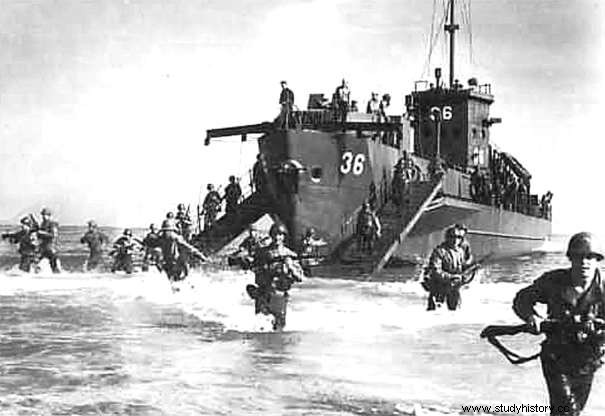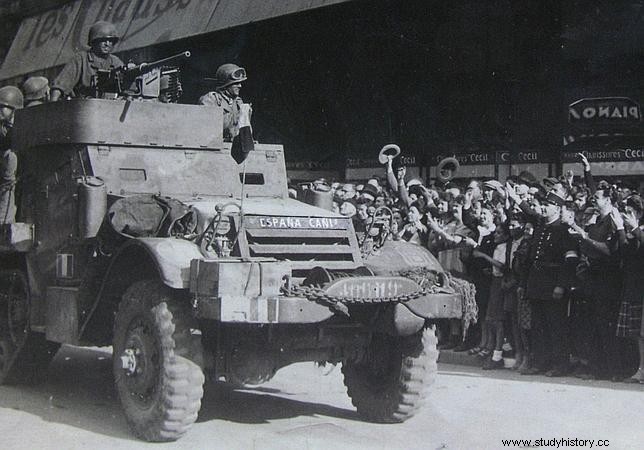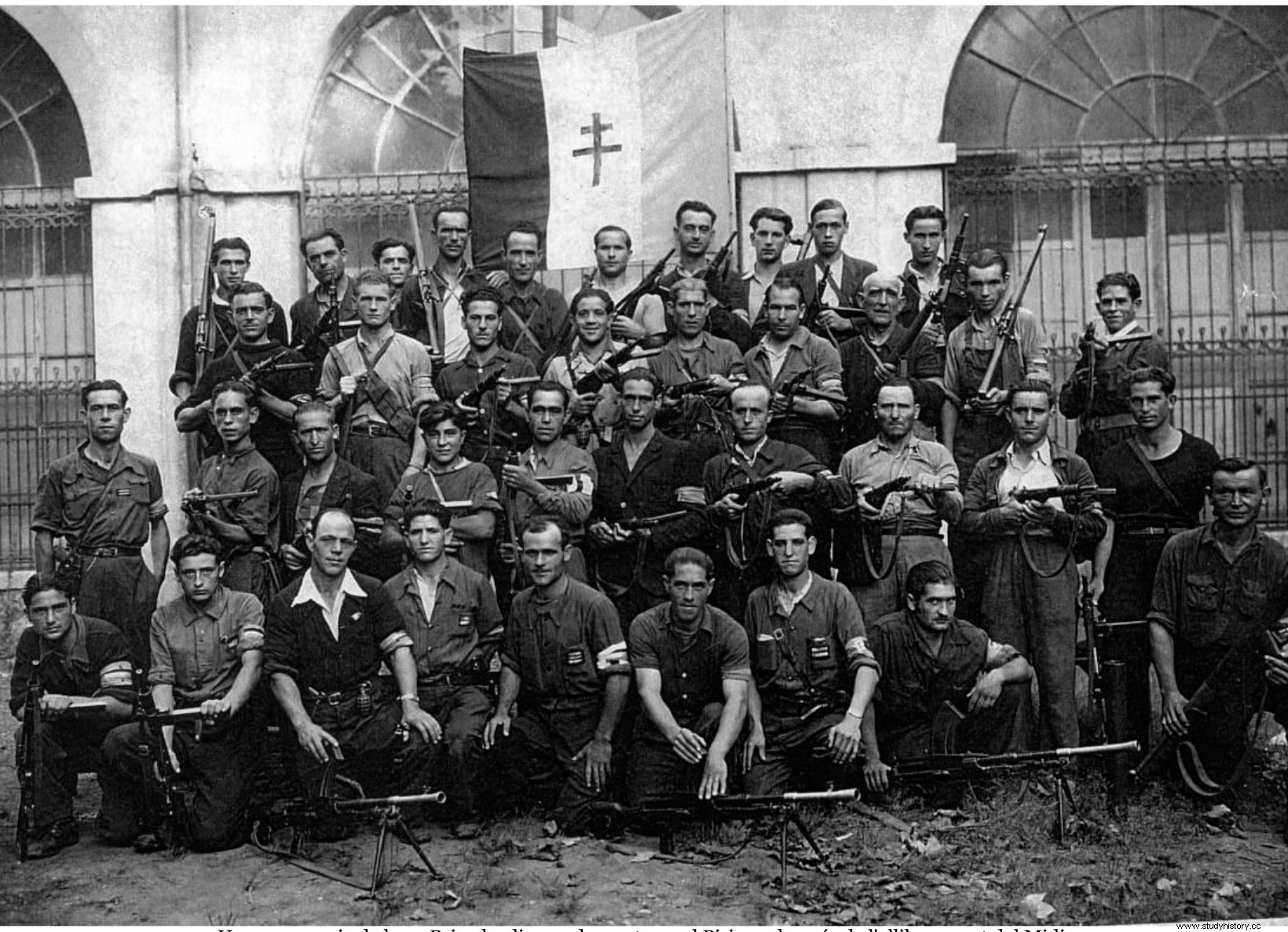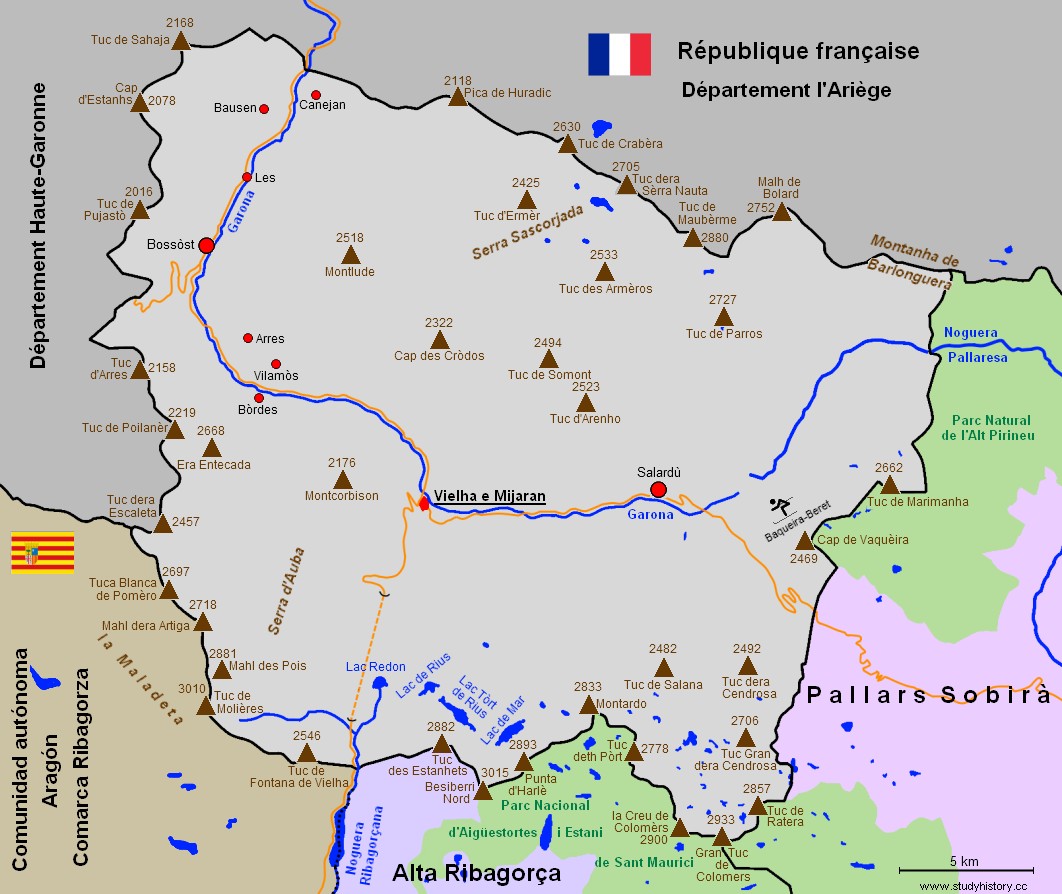The fact that we are going to analyse, although it is part of the History of Spain, is closely linked both with the evolution of the Second World War and with the way in which it ended. This conflict began to change its fate – on the western front, on the eastern front it had done so before – after the Normandy landings (June 6, 1944). Before, however, there had already been elements that announced the decline of the military power of the Axis powers on the western fronts:their surrender in North Africa (May 1943) and the invasion of Italy (July 10, 1943). , landing in Sicily). Rome had been liberated on June 4, 1944. German defeat began to appear once the Soviets began to counterattack on the eastern front – the battles of Stalingrad (1942), Kursk (1943), etc. At that point in the war, the enormous wear and tear on Germany –in terms of men and resources– made it impossible to sustain two combat fronts simultaneously for a long time, especially after the entry of the United States into the war.

The displacement of the fighting fronts towards German territory allowed many Spanish guerrillas, who had been fighting German troops in the French maquis, to abandon that task. Most of these guerrillas had passed through the internment camps after their flight to France at the end of the Spanish Civil War. There the French collaborationist government organized work companies to prepare or maintain infrastructures of military interest.
Over time, some of these companies went on to directly fight the German army, always enrolled in the French resistance, especially from July 1941, when Germany invaded the USSR. This change can be explained because for the most part the members of these companies were communists and the PCE, with the collaboration of the PCF, maintained great influence over them. The German invasion of the USSR implied a change in the attitude of the European communist parties and, therefore, of the PCE, which did not hesitate to join the resistance movement against Nazism and collaborate with other anti-fascist political forces.

The Spanish guerrillas created the XIV Guerrilla Corps, which was commanded by Jesús Ríos García, a former officer of the People's Army of the Republic. From that Corps, in May 1944 a guerrilla force called the Spanish Guerrilla Group (AGE) was formed, made up of about ten thousand men. These became a reserve army that was available for any political or military eventuality –always under the designs of the PCE–.
With the military panorama clarified in France, the leaders of the PCE in Spain and France promoted a political opening towards other anti-Francoist forces willing to share the objective of dislodging Franco from power and restoring the Republic. An example of this position was the promotion of the Spanish National Union (UNE), which had been created in 1941 by Jesús Monzón, at that time a strong man of the PCE in France. The underlying idea was that, once the French territory had been liberated, the military action against Spain would be extended. The objective of the organization was to create a government of National Unity, with forces from the left and the right, which would restore democracy by calling elections. This alternative, which had to be imposed militarily, implied, of course, the invasion of Spain by the allies in order to be viable.
The basic idea of the action plan was to support the armed struggle inside Spain through the maquis, in order to encourage a popular rebellion against the regime and provide reasons for a later intervention by the allies in Spain. The ultimate goal was to overthrow the Franco regime. In this political context, the invasion of the Aran Valley took place, which was intended to fulfill those objectives. All this when it was beginning to be thought that the end of World War II in Europe was near and the allies could open a new front in Spain.

But the allied forces, especially the United States and England, were not interested in prolonging the war, especially when dissensions with the USSR began to surface, differences that would end up leading to the Cold War. The example of the Greek civil war (1944-1946), between communist guerrillas and monarchist forces, was a dissuasive element against any invading action in Spain. Fear of increased communist influence in Europe and war-weariness trumped all other criteria.
On the other hand, within the PCE not all positions were favourable. In fact, Dolores Ibarruri, who was the Secretary General of the PCE at the time, was not informed of the attack. She and Monzón were at odds; For this reason, she decided to wait for events, without explicitly supporting the initiative but also without condemning it, while she sent Santiago Carrillo to Paris to gather information.
The idea of the invasion was also opposed by other members of the party, both politicians and soldiers, more in favor of forming guerrilla groups in the style of the Yugoslav communist partisans than of a direct attack. A posteriori these positions were more sensible. The main problem with the plan was the inconsistency of the PCE's analysis, especially that of Jesús Monzón. Neither the population would rise up nor would the Western powers support a communist-led action. Party informers had already communicated that the population would not support an uprising.
The operation, which received the bombastic name of Reconquest of Spain, was designed to be carried out by the AGE, although only some five thousand troops would participate in the operation, keeping the rest in reserve. The attack consisted of carrying out various skirmishes along the entire Pyrenean border, whose main objective would be distraction, while the main invasion would be directed against Viella, the capital of the Arán Valley. This objective was selected because, once conquered, it was easy to defend, especially in winter when it was cut off from Spain. The consolidation of a Spanish territory where republican legality existed could change many things.
The first clashes –in Navarra and Hendaye– ended in failure, although it is also true that they were insignificant. The main action began on October 19 with the invasion of the Aran Valley. The men of the so-called 204th Guerrilla Division, led by Colonel Vicente López Tovar, entered the valley divided into three columns. This first action allowed them to occupy some hamlets and the town of Bosost, but the assault on Viella, the capital of the valley, was stopped when it was noticed that there was a strong concentration of Francoist troops – Army and Civil Guard – led by General José Moscardó, Captain General of Catalonia at the time.

The main battles took place in Bosost and Bòrdes, in the western part, and in Salardú in the eastern part, all of them on the 19th and 20th. On the same day, the 19th, Francoist reinforcement troops, elite forces led by the Legion and the Regulars, which cut short the possibility of consolidating the conquest of the territory. The clashes resulted in a balance of about 120 deaths by the Francoist troops and about 300 deaths by the guerrillas.
Faced with the impossibility of fulfilling the proposed objectives and with the danger that Franco's troops would cut off the retreat to France, on the 21st Santiago Carrillo, as political leader, and General Luis Fernández ordered the withdrawal of the contingent. This decision was prudent from a tactical point of view, but it meant the failure and political defenestration of Jesús Monzón, passing control of the PCE in Spain and France to Dolores Ibarruri.
The failure is explained because there was no popular support for the invasion; the sociology of the area –small agricultural and livestock owners– did not correspond to the most appropriate profile to achieve possible support for communism. It is also explained by the lack of interest of the victorious powers in World War II – Great Britain especially –, little or nothing in favor of opening another combat front and, moreover, giving prominence to the communists. For his part, Stalin was not interested in confronting the Western powers for a very secondary issue in his strategy at the time.
The invasion served, paradoxically, to unite the Franco regime. Discontent began to spread in the army and in some political sectors –monarchists, pure Falangists, etc.–, boosted by the allied victories and the disappearance of the main international allies of the regime. So the threat of invasion made us forget the internal disagreements to concentrate on saving Franco and his regime.
Bibliography.
Documents RNE (2013):«The maquis:fight and defeat of the anti-Franco guerrilla». http://www.rtve.es/alacarta/audios/documentos-rne/documentos-rne-maquis-kucha-derrota-guerrilla-antifranquista-29-06-13/1903179/
Large, A. (2010). Ines and joy (Kindle ed.). Barcelona:Tusquets.
The invasion of the Valle de Arán (No date). On Wikipedia. Retrieved from https://es.wikipedia.org/wiki/Invasi%C3%B3n_del_Valle_de_Ar%C3%A1n
Linde Ruiz, R. (2015). The invasion of the Aran Valley. Retrieved from https://blogdehistoriaderafa.wordpress.com/2015/11/15/la-invasion-del-valle-de-aran-the-invasion-of-the-valley-of-aran/
Marquina, A. (1980). The invasion of the Arán Valley by the "maquis" could have been manipulated by German espionage. Retrieved from https://elpais.com/diario/1980/05/24/internacional/327967205_850215.html
Sánchez Agustí, F. (2014). Seventy years after the maquis invasion of the Arán Valley. Herald of Madrid . Retrieved from https://heraldodemadrid.net/2014/12/08/setenta-anos-de-la-invasion-maquis-del-valle-de-aran/
Van der Brule, A. (2015). The last cartridge of freedom:the guerrilla that devastated the Arán Valley. Retrieved from http://www.elconfidencial.com/alma-corazon-vida/2015-01-17/el-ultimo-cartucho-la-tormenta-guerrilla-que-asolo-el-valle-de-aran_622949/
